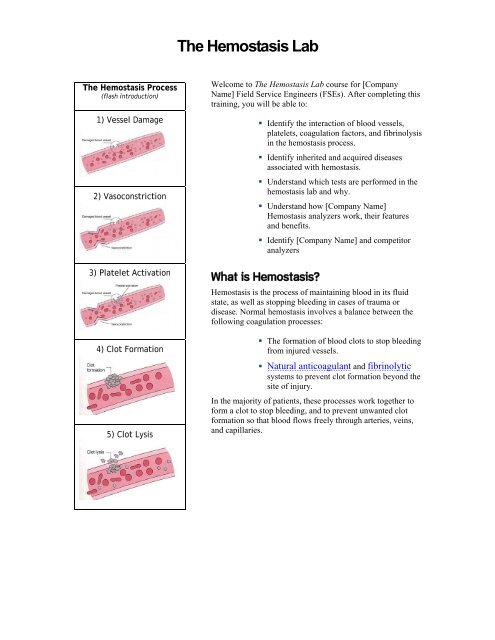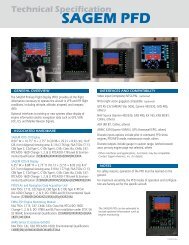The Hemostasis Lab - Styles & Scribbles
The Hemostasis Lab - Styles & Scribbles
The Hemostasis Lab - Styles & Scribbles
Create successful ePaper yourself
Turn your PDF publications into a flip-book with our unique Google optimized e-Paper software.
<strong>The</strong> <strong>Hemostasis</strong> <strong>Lab</strong><br />
<strong>The</strong> <strong>Hemostasis</strong> Process<br />
(flash introduction)<br />
1) Vessel Damage<br />
2) Vasoconstriction<br />
3) Platelet Activation<br />
4) Clot Formation<br />
5) Clot Lysis<br />
Welcome to <strong>The</strong> <strong>Hemostasis</strong> <strong>Lab</strong> course for [Company<br />
Name] Field Service Engineers (FSEs). After completing this<br />
training, you will be able to:<br />
• Identify the interaction of blood vessels,<br />
platelets, coagulation factors, and fibrinolysis<br />
in the hemostasis process.<br />
• Identify inherited and acquired diseases<br />
associated with hemostasis.<br />
• Understand which tests are performed in the<br />
hemostasis lab and why.<br />
• Understand how [Company Name]<br />
<strong>Hemostasis</strong> analyzers work, their features<br />
and benefits.<br />
• Identify [Company Name] and competitor<br />
analyzers<br />
What is <strong>Hemostasis</strong>?<br />
<strong>Hemostasis</strong> is the process of maintaining blood in its fluid<br />
state, as well as stopping bleeding in cases of trauma or<br />
disease. Normal hemostasis involves a balance between the<br />
following coagulation processes:<br />
• <strong>The</strong> formation of blood clots to stop bleeding<br />
from injured vessels.<br />
• Natural anticoagulant and fibrinolytic<br />
systems to prevent clot formation beyond the<br />
site of injury.<br />
In the majority of patients, these processes work together to<br />
form a clot to stop bleeding, and to prevent unwanted clot<br />
formation so that blood flows freely through arteries, veins,<br />
and capillaries.
What Happens if Something Goes Wrong?<br />
Problems arise in hemostasis if blood is lost from the vessels by bleeding or when a clot obstructs a<br />
blood vessel. An abnormality may be minor, such as a bruise, or it may be life threatening, such as a<br />
hemorrhage, thrombus, or embolus.<br />
• Defects in clot formation or overactive fibrinolysis can lead to bleeding disorders.<br />
• Defects in the anticoagulant systems or defective fibrinolysis lead to<br />
hypercoagulation.<br />
<strong>The</strong>se defects can be hereditary or acquired. A growing menu of laboratory tests can be used to<br />
provide a specific diagnosis in affected patients.<br />
<strong>The</strong> <strong>Hemostasis</strong> Process<br />
During normal hemostasis, if a blood vessel is injured, the following interdependent systems are<br />
called to action:<br />
• Vascular system<br />
• Platelets<br />
• Blood coagulation factors<br />
• Fibrinolysis<br />
<strong>The</strong> Role of the Vascular System<br />
When a blood vessel is damaged, the<br />
following vascular reactions can occur:<br />
• Vasoconstriction⎯blood<br />
vessels narrow to reduce<br />
blood flow to a damaged area.<br />
• Collagen exposure⎯ <strong>The</strong><br />
collagen layer is part of the<br />
sub-endothelium of blood<br />
vessels. Platelets and clotting<br />
factors activate when they<br />
come in contact with exposed<br />
collagen, of damaged blood<br />
vessels.<br />
Q. Which hemostasis systems are affected by the exposure to the collagen<br />
layer?<br />
Click here for the answer.<br />
A. Vascular system, platelets, and plasma clotting factors
<strong>The</strong> Role of Platelets<br />
When a blood vessel is damaged, platelets undergo the following changes:<br />
1. Platelets come in contact with exposed<br />
collagen in the wall of damaged cells to<br />
initiate platelet adhesion at the site of injury.<br />
2. Platelet adhesion activates platelets, which<br />
change shape, release ADP, and begin to stick<br />
together.<br />
3. Activated platelets initiate platelet aggregation<br />
in the damaged area, and release platelet factor<br />
3. and Ca + .<br />
4. Platelet aggregation causes the formation of a<br />
platelet plug to stop bleeding in the damaged<br />
area.<br />
Learn more about…Platelet Aggregation<br />
Although platelets are not complete cells, they are quite active chemically.<br />
Over 40 substances are secreted from platelets during the “release” reaction<br />
that accompanies aggregation, including adenosine diphosphate (ADP).<br />
Within one minute, fibrin strands begin to appear, trapping RBCs, and WBCs<br />
into the clot to make it stronger.
<strong>The</strong> Role of Coagulation Factors<br />
When a blood vessel is damaged, coagulation factors interact to form a stable fibrin clot to stop<br />
bleeding. Coagulation factors are:<br />
• Made up of plasma proteins, except for calcium (Factor IV), which is a mineral, and<br />
thromboplastin, which is a lipoprotein released from tissue.<br />
• Produced in the liver, except for Factor VIII (hemolytic factor), which is produced<br />
in multiple organs.<br />
• Circulated in plasma in an inactive form as enzyme precursors, or as catalysts for<br />
other enzymatic reactions.<br />
What’s the deal with these factor names?<br />
Coagulation factors are named according to a system of Roman numerals that relate to their order<br />
of discovery⎯not to their order used in a reaction.<br />
• Coagulation factor numerals also have synonyms. For example, factor I is more commonly known<br />
as fibrinogen, and factor III is more commonly known as thromboplastin.<br />
• Coagulation factors initially circulate in the plasma in an inactive form. Upon activation, factor<br />
numerals are designated by the subscript “a” (e.g., XIIa ).<br />
Keeping coagulation factor numbers and names straight is no easy task! For example, number VI is no<br />
longer used, and two factors are named but have no numbers! Click a coagulation factor below to<br />
view its synonym. Factors marked * are more commonly referred to by their synonyms, rather than<br />
their Roman numerals.<br />
Factor I*<br />
Fibrinogen<br />
Factor V<br />
Prothrombin<br />
accelerator<br />
Factor X<br />
Stuart-Prower<br />
factor (PTC)<br />
<br />
No number<br />
assigned<br />
High Molecular<br />
Weight<br />
Kininogen<br />
(HMWK) or<br />
Fitzgerald factor<br />
Factor II*<br />
Prothrombin<br />
Factor VII<br />
Proconvertin<br />
Factor XI<br />
Plasma<br />
thromboplastin<br />
antecedent<br />
(PTA)<br />
No number<br />
assigned<br />
Prekallikrein (PK)<br />
or Fletcher factor<br />
Factor III*<br />
Thromboplastin<br />
or tissue factor<br />
Factor VIII:C<br />
Antihemophilic<br />
factor<br />
Factor XII<br />
Hageman factor<br />
(contact factor)<br />
Factor IV*<br />
Calcium<br />
Factor IX<br />
Christmas factor<br />
Factor XIII<br />
Fibrin-stabilizing<br />
factor<br />
…end of sample…





